LG G2 and MSM8974 Snapdragon 800 - Mini Review
by Brian Klug on September 7, 2013 1:11 AM EST- Posted in
- Smartphones
- LG
- Mobile
- LG G2
- Android 4.2
- MSM8974
- Snapdragon 800
CPU Performance
LG's G2 features a quad-core Snapdragon 800 SoC (MSM8974). For a quick refresher, Snapdragon 800 features four Krait 400 cores running at up to 2.3GHz courtesy of TSMC's 28nm HPM process. The 2.3GHz max clock speed comes at a surprisingly low voltage thanks to the low power HPM process. Gone are the days of 1.4V to hit near-2GHz frequencies it seems, instead 8974 will hit 2.3 GHz at around 1V. Krait 400 improves L2 access latencies over Krait 300 (which is at the heart of Snapdragon 600 and S4 Pro) and is optimized for higher frequency operation, but Krait 400 is otherwise architecturally similar to Krait 300. Make no mistake, MSM8974 is the new high-end, pushing Snapdragon 600 and S4 Pro parts further down into midrange category. There are other SoC level enhancements as well, including things like a new version of the Hexagon DSP and obviously Adreno 330 vs. Adreno 320 (which I'll get to later). We already ran through a performance preview of Snapdragon 800/MSM8974 using Qualcomm's 8974 Tablet Mobile Development Platform, but today we get to do the same with the G2.
LG was pretty eager to get us a G2 sample as early as possible, unfortunately that comes at the expense of software maturity. LG made it very clear to us that the International G2 sample (LG-D802) we received has nowhere near final software, and as a result may not deliver performance indicative of what we'll see when the device shows up later this month. This puts us in an interesting situation as we want to see how close shipping Snapdragon 800 devices come to the Snapdragon MDP/T we tested back in June. Software maturity aside, there's no skirting the fact that the G2 simply has a smaller chassis and perhaps lower thermal limits than the tablet MSM8974 MDP/T we tested previously.
The most interesting comparison points here will be to LG's Optimus G Pro which ships with a Snapdragon 600 (4 x Krait 300 running at 1.7GHz), the Exynos 5 Octa based Galaxy S 4 (SHVE300S) and to the MDP/T. As always, we'll start with a look at CPU performance.
The state of CPU performance testing under Android is unfortunately still quite broken. We're using a mix of browser based tests with Java & Native apps (AndEBench).
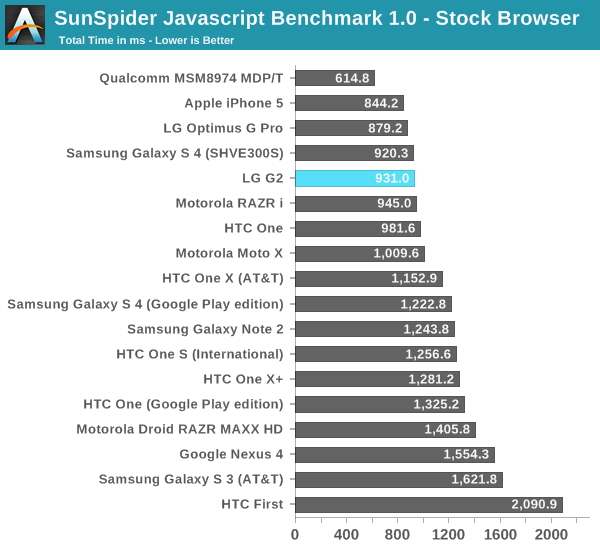
SunSpider has quickly become an exercise in browser optimization rather than platform performance. Qualcomm's browser optimizations are clearly good for showing off Snapdragon 800's potential, however the G2 doesn't appear to have the same optimizations in place (yet). Performance isn't bad, but it's merely on par with Snapdragon 600 and ARM's Cortex A15.
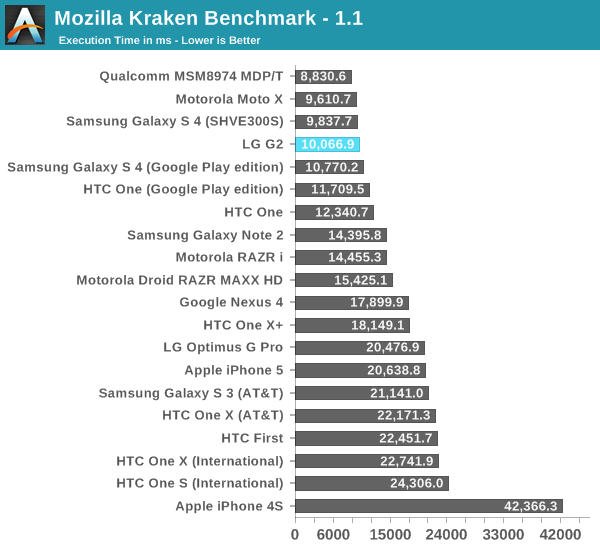
Kraken is an interesting test as it has (thus far) remained less of a browser optimization target. Kraken is also a physically larger and longer benchmark, which provides results that I tend to be a little happier with. The G2 once again falls short of Qualcomm's MDP/T, but given its early software I'm not too surprised. Performance is roughly on par with the Exynos 5 Octa, and slightly behind the very high clocked Snapdragon 600 in the nearly stock Moto X.

Octane is the first benchmark where we see the Snapdragon 800 flex its potential. Here the G2 not only ties the Snapdragon 800 MDP/T, but it also roughly equals the performance of the Cortex A15 based Exynos 5 Octa. Ultimately that's the comparison that Qualcomm will be most interested in winning. If Snapdragon 800 can deliver better performance (or at least perf per watt) than the Cortex A15, it'll be a definite win for Qualcomm.
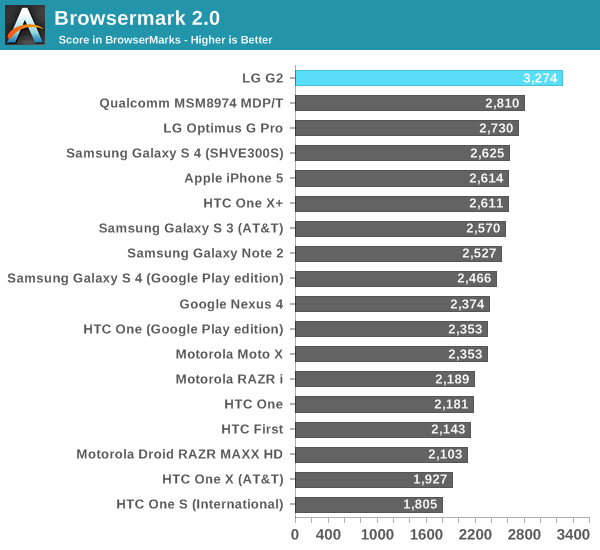
If Octane had the S800 in the proverbial passing lane, Browsermark 2.0 shows the G2 in the clear lead. Here LG was able to even outperform Qualcomm's own reference design by 16%. I suspect this has more to do with browser optimizations than anything else though, as the S600 based Optimus G Pro also does extremely well.
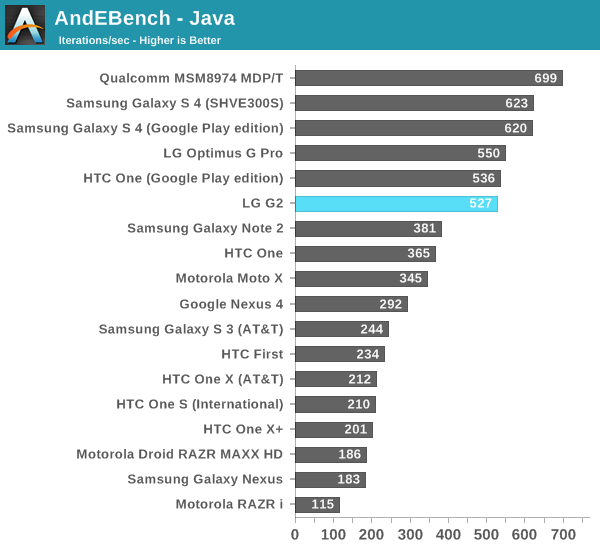
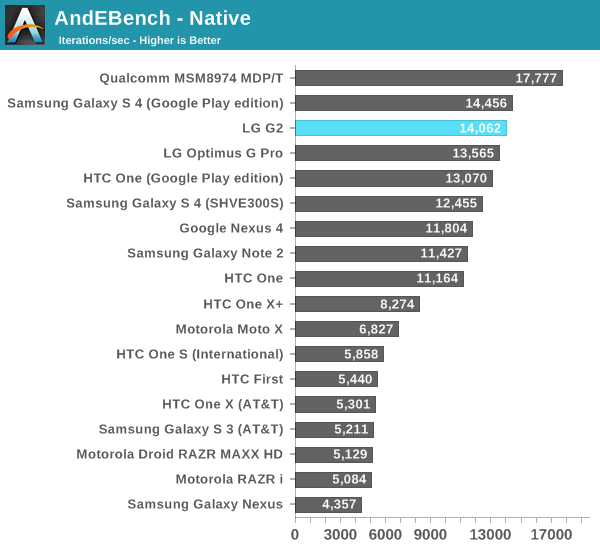
AndEBench provides us with very low level look at SoC performance. I'm not a huge fan of these types of tests, especially ones that aggregate a bunch of microbenchmarks and attempt to present a single performance number. AndEBench is unique (and useful) in that it presents performance in both native code and Dalvik interpreted states. The G2's native performance here is quite good, but it's actually equalled by the Galaxy S 4 GPe and not far ahead of the Optimus G Pro. I suspect we're once again seeing the limits of early software rather than a full understanding of Snapdragon 800's performance in a retail device. Dalvik performance is a bit worse. The relatively high ranking of the Google Play Edition devices points to software optimization being a culprit here.
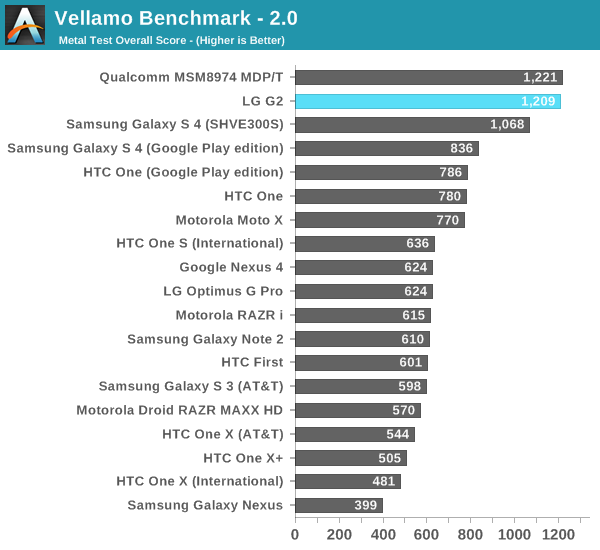

Both Vellamo tests put the G2 on par with Qualcomm's Snapdragon 800 MDP/T.








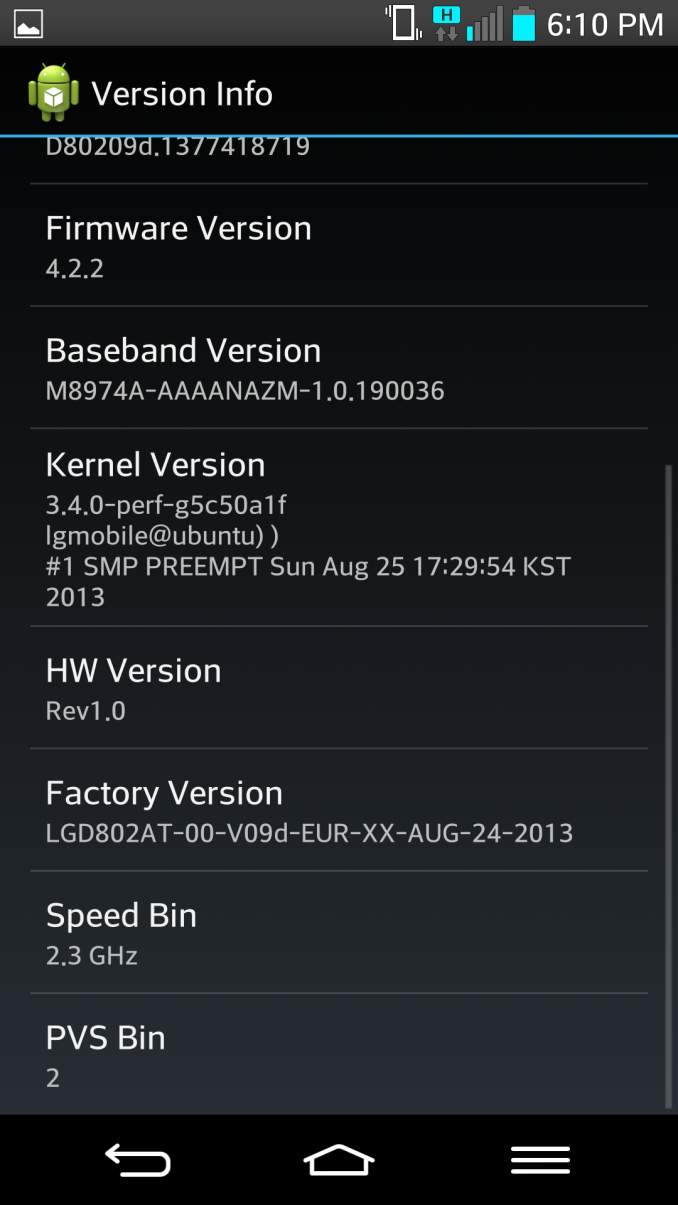
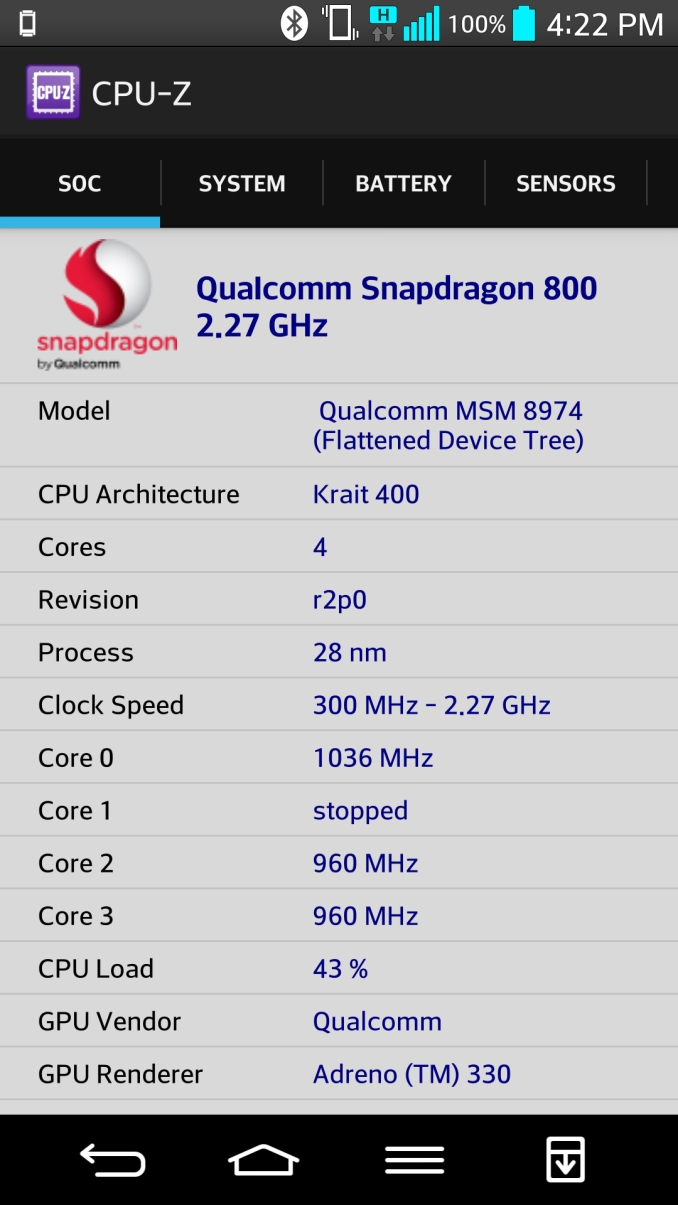








120 Comments
View All Comments
Paulman - Saturday, September 7, 2013 - link
"<b>WOW...</b> wow.... wow, wow..." - That's literally what came out of my mouth when I first saw those battery life graphs. Amazing, LG. GG WPPaulman - Saturday, September 7, 2013 - link
"Gone are the days of 1.4V to hit near-2GHz frequencies it seems, instead 8974 will hit 2.3 GHz at around 1V." - That elicited another 'Wow' from me.andykins - Saturday, September 7, 2013 - link
That is an insane difference. But is there some downside too? Seems a bit good to be true.Froyorkshire - Saturday, September 7, 2013 - link
Heat, most likely. The LG G2 seems to have it taken care of but if the Nexus 4 was any indication, the Nexus 5 needs to have a better-engineered body to handle the S800's potential heat.tuxRoller - Saturday, September 7, 2013 - link
Why would you have more heat when pushing less V and A? Yes, it is clocked higher and has a more powerful gpu so its tdp (or whatever) will be higher than s600 soc, but at the same clocks as the pre-800s it should use less power.This shouldn't be a surprise since this is, apparently, the first time snapdragons have used 28nm hpm, and with new processes come inherent advantages (also problems, but heat shouldn't be one of them unless you are running it at full-tilt).
theduckofdeath - Sunday, September 8, 2013 - link
They reduce the voltage to reduce the wattage, which is what heat is generated from.gwydionjhr - Saturday, September 7, 2013 - link
The side by side comparison video is very interesting. I've only have a light understanding of what I'm seeing, and if you get a chance, I'd really love to get your impressions on how each of these OIS/EIS systems perform. The one question that came to me as my eyes darted back and forth tying to compare the two videos, was that the 1020 OIS seemed to work pretty well, right up to the moment of impact on your footfall. I'm I seeing that right? Is this a result of the weight of the larger sensor in the 1020 maxing out the capabilities of the OIS when those large acceleration forces hit it?Brian Klug - Saturday, September 7, 2013 - link
Accommodation angle is the big game, and they're all also tuned differently too it seems. I'm not walking very aggressively or stomping around either, but trying to walk normally. I wanted to include the Lumia 920 as well but didn't bring it, the 925 seems to be pretty similar to what I remember the 920 being like though.-Brian
UpSpin - Saturday, September 7, 2013 - link
It's funny that in my opinion the 1020 (and so also the 808) does one of the worst jobs in OIS, the 925 the best followed by the HTC One and Moto X. Between them is the rest. LG2 on par with the 1020, in some scenes worse, in some better.In the 1020 vs. 925 comparison, at the beginning, Brian walks along a footway, the 1020 video has a very obvious and penetrant periodic shaking/reflex which does not exist in the 925 or HTC One video.
At the very beginning of the Moto X comparison we see a handrail with a building behinde it, the Moto X video is sharp and steady, the 1020 video wobbles in the z-direction
The colors in the 1020 are the most vivid ones, but in my opinion also the most over saturated and artifical ones. It does a good job in capturing the blue of the sky, but therefore darker details aren't visible on the 1020 videos. (handrail at the end of the test videos)
It's obvious that using a larger sensor a OIS is harder to implement, but I find it odd that Nokia hasn't made any use of the 41MP in video recording mode by additionally implementing an EIS.
But I found it surprising how good or even better the competition is (or how bad the 1020 in videos is), using a cheaper and less intrusive sensor. (in photos the 1020 will probably (and hopefully) remain unbeaten)
Krysto - Sunday, September 8, 2013 - link
It seemed to me the LG one beat the 1020 OIS slightly. The 920 one was the best though, as Brian said. But 920 had far from accurate colors.